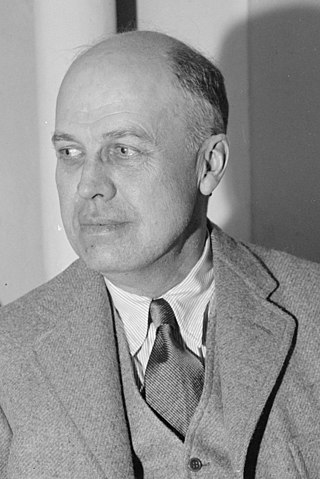
Edward Hopper was an American realist painter and printmaker. While he is widely known for his oil paintings, he was equally proficient as a watercolorist and printmaker in etching.
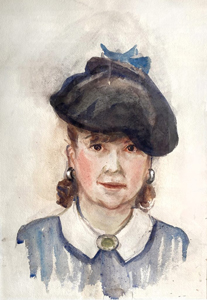
Josephine Verstille Hopper was an American painter who studied under Robert Henri and Kenneth Hayes Miller, and won the Huntington Hartford Foundation fellowship. She was the wife of Edward Hopper, whom she married in 1924.
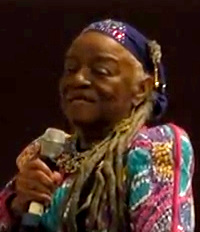
Faith Ringgold is an American painter, painting on different materials including fabric, a published author, mixed media sculptor, performance artist, and intersectional activist, perhaps best known for her narrative quilts.

Nighthawks is a 1942 oil-on-canvas painting by the American artist Edward Hopper that portrays four people in a downtown diner late at night as viewed through the diner's large glass window. The light coming from the diner illuminates a darkened and deserted urban streetscape.
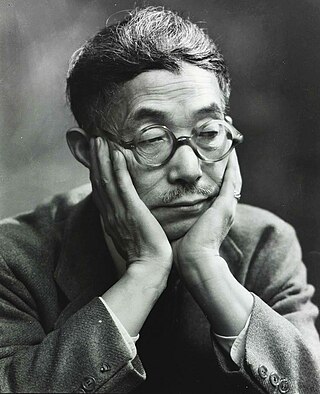
Yasuo Kuniyoshi was an eminent 20th-century Japanese-American painter, photographer and printmaker.

The Art Institute of Chicago, founded in 1879, is one of the oldest and largest art museums in the United States. It is based in the Art Institute of Chicago Building in Chicago's Grant Park. Internationally recognized for its curatorial efforts and popularity among visitors, its collection, stewarded by 11 curatorial departments, is encyclopedic, and includes works such as Georges Seurat's A Sunday on La Grande Jatte, Pablo Picasso's The Old Guitarist, Edward Hopper's Nighthawks, and Grant Wood's American Gothic. Its permanent collection of nearly 300,000 works of art is augmented by more than 30 special exhibitions mounted yearly that illuminate aspects of the collection and present curatorial and scientific research.

Chop Suey (1929) is an oil painting on canvas by the American artist Edward Hopper. The foreground of the work portrays two women in conversation at a restaurant. In November 2018, it was sold at $92 million, a record price for the artist's work.

Automat is a 1927 oil painting by the American realist painter Edward Hopper. The painting was first displayed on Valentine's Day 1927 at the opening of Hopper's second solo show, at the Rehn Galleries in New York City. By April it had been sold for $1,200. The painting is today owned by the Des Moines Art Center, in Iowa.
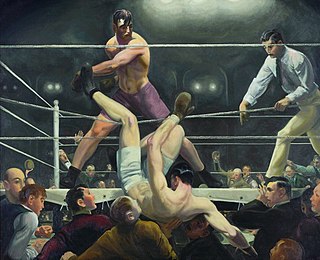
American Realism was a style in art, music and literature that depicted contemporary social realities and the lives and everyday activities of ordinary people. The movement began in literature in the mid-19th century, and became an important tendency in visual art in the early 20th century. Whether a cultural portrayal or a scenic view of downtown New York City, American realist works attempted to define what was real.
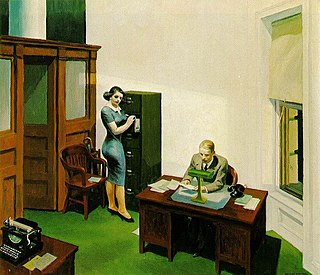
Office at Night is a 1940 oil-on-canvas painting by the American realist painter Edward Hopper. It is owned by the Walker Art Center in Minneapolis, Minnesota, which purchased it in 1948.

Hotel Lobby is a 1943 oil painting on canvas by American realist painter Edward Hopper; it is held in the collection of the Indianapolis Museum of Art (IMA), in Indianapolis, Indiana, United States.

Early Sunday Morning is a 1930 oil painting by American artist Edward Hopper.

East Wind Over Weehawken is an 1934 oil painting on canvas by American realist painter Edward Hopper. It was held in the collection of the Pennsylvania Academy of Fine Arts in the United States from 1952 until its sale to an anonymous buyer in December 2013. That sale brought a record price for a Hopper.

Manhattan Bridge Loop is a 1928 oil painting by American artist Edward Hopper, depicting the Manhattan Bridge in New York City. It is on display in the Addison Gallery of American Art of the Phillips Academy in Andover, Massachusetts, which received the painting as a gift from art collector Stephen Carlton Clark in 1932.
Sarai Sherman was a Pennsylvania-born Jewish American artist whose work, both in America and Europe shaped international views of women and abstract expressionism. She was a significant twentieth century painter and sculptor known for her abstract paintings, prints and ceramics.
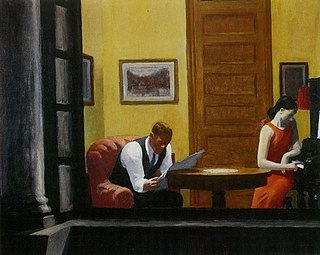
Room in New York is a 1932 oil-on-canvas painting by the American artist Edward Hopper that portrays two individuals in a New York City flat. It is held in the collection of the Sheldon Museum of Art. The painting is said to have been inspired by the glimpses of lighted interiors seen by the artist near the district where he lived in Washington Square.

New York Movie is an oil on canvas painting by American painter Edward Hopper. The painting was begun in December of 1938 and finished in January of 1939. Measuring 32 1/4 x 40 1/8", New York Movie depicts a nearly empty movie theater occupied with a few scattered moviegoers and a pensive usherette lost in her thoughts. Praised for its brilliant portrayal of multiple light sources, New York Movie is one of Hopper's well-regarded works. Despite the fact that the movie in the painting itself is not known, Hopper's wife and fellow painter Josephine Hopper wrote in her notes on New York Movie that the image represents fragments of snow-covered mountains.

Ground Swell is a 1939 painting by American artist Edward Hopper which depicts five people on a heeling catboat in a light swell, looking at an ominous buoy. It was in the collection of the Corcoran Gallery of Art from 1943 until it was purchased by the National Gallery of Art in Washington, D.C. in 2014.

Sun in an Empty Room is a 1963 painting by American realist Edward Hopper (1882–1967). It is a late period painting completed at his Cape Cod summer home and studio in South Truro, Massachusetts, just four years before his death at age 84. The work depicts a room, seemingly empty, except for light coming through a window, reflecting along the walls and floor. Leaves on a tree or bush can be seen just outside the window.
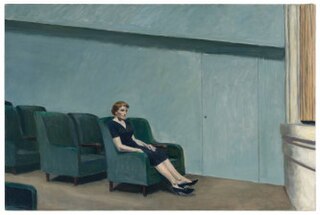
Intermission is a 1963 painting by American realist Edward Hopper (1882–1967). It is a late period painting completed between March and April at his New York home and studio in Washington Square Park, in the Greenwich Village neighborhood of Lower Manhattan, New York City, just four years before his death at age 84. The work depicts a woman in a theater wearing a blue and black dress and black shoes, sitting by herself in a green aisle seat near a blue wall below a balcony. It is one of the largest paintings ever completed by Hopper, and is his penultimate theater-themed work, followed by Two Comedians (1966), his very last painting. It was acquired by the San Francisco Museum of Art in 2012.



















